The Influence of Unmanned Aerial Vehicle Wind Field on the Pesticide Droplet Deposition and Control Effect in Cotton Fields
Abstract
1. Introduction
2. Materials and Methods
2.1. Field Plot
2.2. Sprayers
2.3. Experimental Design
2.4. Droplet Deposition and Pesticide Utilization Rate
2.4.1. Pesticide Utilization Rate
2.4.2. Droplet Deposition
2.5. Control Effect
2.5.1. Aphids
2.5.2. Boll Opening and Defoliation
2.6. Data Analysis
3. Results
3.1. Effect of UAV Wind Field on Droplet Coverage
3.2. Effect of UAV Wind Field on Droplet Density
3.3. Effect of UAV Wind Field on Droplet Deposition
3.4. Effect of UAV Downwash Airflow on Droplet Distribution Uniformity and Penetration
3.5. Effect of UAV Wind Field on Pesticide Utilization Rate
3.6. Effect of UAV Wind Field on Spraying Effect
4. Conclusions
Author Contributions
Funding
Data Availability Statement
Conflicts of Interest
References
- Wang, X.N.; Liu, Y.P.; Wang, S.L.; Wang, S.W. Effects of Spray Adjuvants on Droplet Deposition Characteristics in Litchi Trees under UAV Spraying Operations. Agronomy 2024, 14, 2125. [Google Scholar] [CrossRef]
- Raouhi, E.M.; Lachgar, M.; Hrimech, H.; Kartit, A. Unmanned Aerial Vehicle-Based Applications in Smart Farming: A Systematic Review. Int. J. Adv. Comput. Sci. Appl. 2023, 14, 1150–1165. [Google Scholar] [CrossRef]
- Shaikh, F.K.; Karim, S.; Zeadally, S.; Nebhen, J. Recent Trends in Internet-of-Things-Enabled Sensor Technologies for Smart Agriculture. IEEE Internet Things J. 2022, 9, 23583–23598. [Google Scholar] [CrossRef]
- Delavarpour, N.; Koparan, C.; Zhang, Y.; Steele, D.D.; Betitame, K.; Bajwa, S.G.; Sun, X. A Review of the Current Unmanned Aerial Vehicle Sprayer Applications in Precision Agriculture. J. ASABE 2023, 66, 703–721. [Google Scholar] [CrossRef]
- Nahiyoon, S.A.; Ren, Z.; Wei, P.; Li, X.; Li, X.; Xu, J.; Yan, X.; Yuan, H. Recent Development Trends in Plant Protection UAVs: A Journey from Conventional Practices to Cutting-Edge Technologies—A Comprehensive Review. Drones 2024, 8, 457. [Google Scholar] [CrossRef]
- Hu, P.; Zhang, R.R.; Yang, J.X.; Chen, L.P. Development Status and Key Technologies of Plant Protection UAVs in China: A Review. Drones 2022, 6, 354. [Google Scholar] [CrossRef]
- Rajesh, P.; Mohankumar, A.P.; Kavitha, R.; Suthakar, B.; Ganesan, K. Optimizing the impact of spray characteristics of hybrid drone on spray deposition in cotton crops. Curr. Sci. 2024, 127, 297–306. [Google Scholar] [CrossRef]
- Eun, H.R.; Kim, S.H.; Lee, Y.H.; Kim, S.M.; Lee, Y.J.; Yung, H.Y.; Min, Y.G.; Noh, H.H.; Shin, Y. Comparison of off-target pesticide drift in paddy fields from unmanned aerial vehicle spraying using cellulose deposition sampler. Ecotoxicol. Environ. Saf. 2024, 285, 117075. [Google Scholar] [CrossRef]
- Yallappa, D.; Kavitha, R.; Surendrakumar, A.; Suthakar, B.; Kumar, A.P.; Kalarani, M.K.; Kannan, B. Effect of downwash airflow distribution of multi-rotor unmanned aerial vehicle on spray droplet deposition characteristics in rice crop. Curr. Sci. 2023, 125, 172–182. [Google Scholar] [CrossRef]
- Zhu, Y.Z.; Guo, Q.W.; Tang, Y.; Zhu, X.; He, Y.; Huang, H.S.; Luo, S.M. CFD simulation and measurement of the downwash airflow of a quadrotor plant protection UAV during operation. Comput. Electron. Agric. 2022, 201, 107286. [Google Scholar] [CrossRef]
- Guo, Q.; Zhu, Y.; Tang, Y.; Hou, C.; Fang, M.; Chen, X. Numerical Simulation of the Effects of Downwash Airflow and Crosswinds on the Spray Performance of Quad-Rotor Agricultural UAVs. Smart Agric. Technol. 2025, 11, 100940. [Google Scholar] [CrossRef]
- Li, X.; Giles, D.K.; Andaloro, J.T.; Long, R.; Lang, E.B.; Watson, L.J.; Qandah, I. Comparison of UAV and fixed-wing aerial application for alfalfa insect pest control: Evaluating efficacy, residues, and spray quality. Pest Manag. Sci. 2021, 77, 4980–4992. [Google Scholar] [CrossRef] [PubMed]
- Martin, D.E.; Latheef, M.A. Payload Capacities of Remotely Piloted Aerial Application Systems Affect Spray Pattern and Effective Swath. Drones 2022, 6, 205. [Google Scholar] [CrossRef]
- Guo, Q.W.; Zhu, Y.Z.; Tang, Y.; Hou, C.J.; He, Y.; Zhuang, J.J.; Zheng, Y.L.; Luo, S.M. CFD simulation and experimental verification of the spatial and temporal distributions of the downwash airflow of a quad-rotor agricultural UAV in hover. Comput. Electron. Agric. 2020, 172, 105343. [Google Scholar] [CrossRef]
- Pachuta, A.; Berner, B.; Chojnacki, J.; Moitzi, G.; Dvořák, J.; Keutgen, A.; Najser, J.; Kielar, J.; Najser, T.; Mikeska, M. Propellers Spin Rate Effect of a Spraying Drone on Quality of Liquid Deposition in a Crown of Young Spruce. Agriculture 2023, 13, 1584. [Google Scholar] [CrossRef]
- Li, J.Y.; Lan, Y.B.; Wang, J.W.; Chen, S.D.; Yao, W.X.; Huang, C.; Liu, Q.; Liang, Q.P. Distribution law of rice pollen in the wind field of small UAV. Int. J. Agric. Biol. Eng. 2017, 10, 32–40. [Google Scholar]
- Tang, Q.; Zhang, R.R.; Chen, L.P.; Xu, M.; Yi, T.C.; Zhang, B. Droplets movement and deposition of an eight-rotor agricultural UAV in downwash flow field. Int. J. Agric. Biol. Eng. 2017, 10, 47–56. [Google Scholar]
- Guo, Q.W.; Huang, F.; Hou, C.J.; Zhuang, J.J.; Huang, H.S.; Tan, Z.P.; Fang, M.W.; Tang, Y. Numerical simulation and validation of downwash airflow during dual-aircraft collaborative operations of quad-rotor agricultural UAVs. Measurement 2025, 247, 116782. [Google Scholar] [CrossRef]
- Liu, Z.; Gao, R.; Zhao, Y.; Wu, H.; Liang, Y.; Liang, K.; Liu, D.; Huang, T.; Xie, S.; Lv, J.; et al. Study on the Characteristics of Downwash Field Range and Consistency of Spray Deposition of Agricultural UAVs. Agriculture 2024, 14, 931. [Google Scholar] [CrossRef]
- Shi, Q.; Pan, Y.; He, B.; Zhu, H.; Liu, D.; Shen, B.; Mao, H. The Airflow Field Characteristics of UAV Flight in a Greenhouse. Agriculture 2021, 11, 634. [Google Scholar] [CrossRef]
- Chojnacki, J.; Pachuta, A. Impact of the Parameters of Spraying with a Small Unmanned Aerial Vehicle on the Distribution of Liquid on Young Cherry Trees. Agriculture 2021, 11, 1094. [Google Scholar] [CrossRef]
- Martin, D.E.; Woldt, W.E.; Latheef, M.A. Effect of Application Height and Ground Speed on Spray Pattern and Droplet Spectra from Remotely Piloted Aerial Application Systems. Drones 2019, 3, 83. [Google Scholar] [CrossRef]
- Tang, Y.; Fu, Y.Q.; Guo, Q.W.; Huang, H.S.; Tan, Z.P.; Luo, S.M. Numerical simulation of the spatial and temporal distributions of the downwash airflow and spray field of a co-axial eight-rotor plant protection UAV in hover. Comput. Electron. Agric. 2023, 206, 107634. [Google Scholar] [CrossRef]
- Yallappa, D.; Kavitha, R.; Surendrakumar, A.; Balaji, K.; Suthakar, B.; Kumar, A.P.M.; Ravi, Y.; Ashoka, A.; Kavan, K. Downwash airflow distribution pattern of hexa-copter unmanned aerial vehicles. Int. J. Agric. Biol. Eng. 2024, 17, 24–34. [Google Scholar]
- Zhang, H.; Qi, L.J.; Wu, Y.L.; Cheng, Z.Z.; Liu, G.G.; Elizabeth, M.; Xiao, Y.; Yang, Z.P. Distribution characteristics of rotor downwash airflow field under spraying on orchard using unmanned aerial vehicle. Trans. CSAE 2019, 35, 44–54. [Google Scholar]
- Kumar, S.P.; Jat, D.; Sahni, R.K.; Jyoti, B.; Kumar, M.; Subeesh, A.; Parmar, B.S.; Mehta, C.R. Measurement of droplets characteristics of UAV based spraying system using imaging techniques and prediction by GWO-ANN model. Measurement 2024, 234, 114759. [Google Scholar] [CrossRef]
- Grant, S.; Perine, J.; Abi-Akar, F.; Lane, T.; Kent, B.; Mohler, C.; Scott, C.; Ritter, A. A Wind-Tunnel Assessment of Parameters That May Impact Spray Drift during UAV Pesticide Application. Drones 2022, 6, 204. [Google Scholar] [CrossRef]
- Li, H.Z.; Zhu, H.; Jiang, Z.H.; Lan, Y.B. Performance characterization on downwash flow and spray drift of multirotor unmanned agricultural aircraft system based on CFD. Int. J. Agric. Biol. Eng. 2022, 15, 1–8. [Google Scholar] [CrossRef]
- Shi, Q.; Liu, D.; Mao, H.P.; Shen, B.G.; Li, M.Q. Wind-induced response of rice under the action of the downwash flow field of a multi-rotor UAV. Biosyst. Eng. 2021, 203, 60–69. [Google Scholar] [CrossRef]
- Duan, L.; Fang, Z.H.; Dou, Z.C.; Liu, Y.P.; Wen, M.K.; Hou, T.Y.; Han, X.Q. The Relationship Between Droplet Density and the Defoliation Effect of Cotton Harvest Aids. ACS Omega 2024, 9, 16486–16495. [Google Scholar] [CrossRef]
- NY/T 3630.1-2020; Technical Methodology of Determining Pesticide Utilization Rate in FIELD-PART 1: Technical Methodology of Determining Pesticide Deposition Rate by Foliar Spray in Field Crop—Allura Red as a Tracer. China Agricultural Press: Beijing, China, 2020.
- Hussain, M.; Wang, Z.; Huang, G.; Mo, Y.; Kaousar, R.; Duan, L.; Tan, W. Comparison of Droplet Deposition, 28-Homobrassinolide Dosage Efficacy and Working Efficiency of the Unmanned Aerial Vehicle and Knapsack Manual Sprayer in the Maize Field. Agronomy 2022, 12, 385. [Google Scholar] [CrossRef]
- Emanuele, C.; Sebastian, L.; Luciano, C.; Salvatore, P.; Giuseppe, M. Shape descriptor analysis of droplet stains on water sensitive papers. Smart Agric. Technol. 2025, 11, 2772–3755. [Google Scholar]
- Mseddi, J.; Farhat-Touzri, D.B.; Azzouz, H. Selection and characterization of thermotolerant Beauveria bassiana isolates and with insecticidal activity against the cotton-melon aphid Aphis gossypii (Glover) (Hemiptera: Aphididae). Pest Manag. Sci. 2022, 78, 2183–2195. [Google Scholar] [CrossRef]
- Martin, D.E.; Perine, J.W.; Grant, S.; Abi-Akar, F.; Henry, J.L.; Latheef, M.A. Spray Deposition and Drift as Influenced by Wind Speed and Spray Nozzles from a Remotely Piloted Aerial Application System. Drones 2025, 9, 66. [Google Scholar] [CrossRef]
- Ding, W.M.; Ding, S.M.; Fu, X.M.; Zhou, L.F.; Chen, J. Design and experiment of combined disc air-assisted orchard sprayer. Trans. Chin. Soc. Agric. Eng. 2015, 31, 64–71. [Google Scholar]
- Martin, D.E.; Latheef, M.A. Aerial Electrostatic Spray Deposition and Canopy Penetration in Cotton. J. Electrost. 2017, 90, 38–44. [Google Scholar] [CrossRef]
- Ranabhat, S.; Price, R. Effects of Flight Heights and Nozzle Types on Spray Characteristics of Unmanned Aerial Vehicle (UAV) Sprayer in Common Field Crops. AgriEngineering 2025, 7, 22. [Google Scholar] [CrossRef]
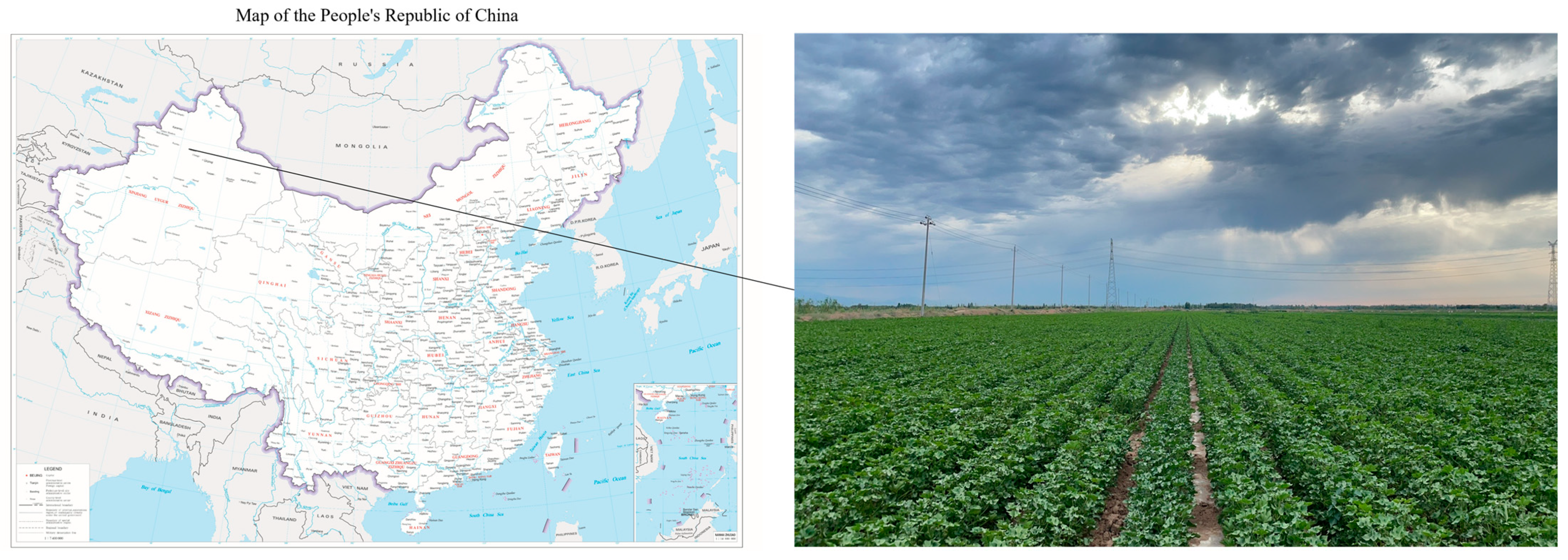

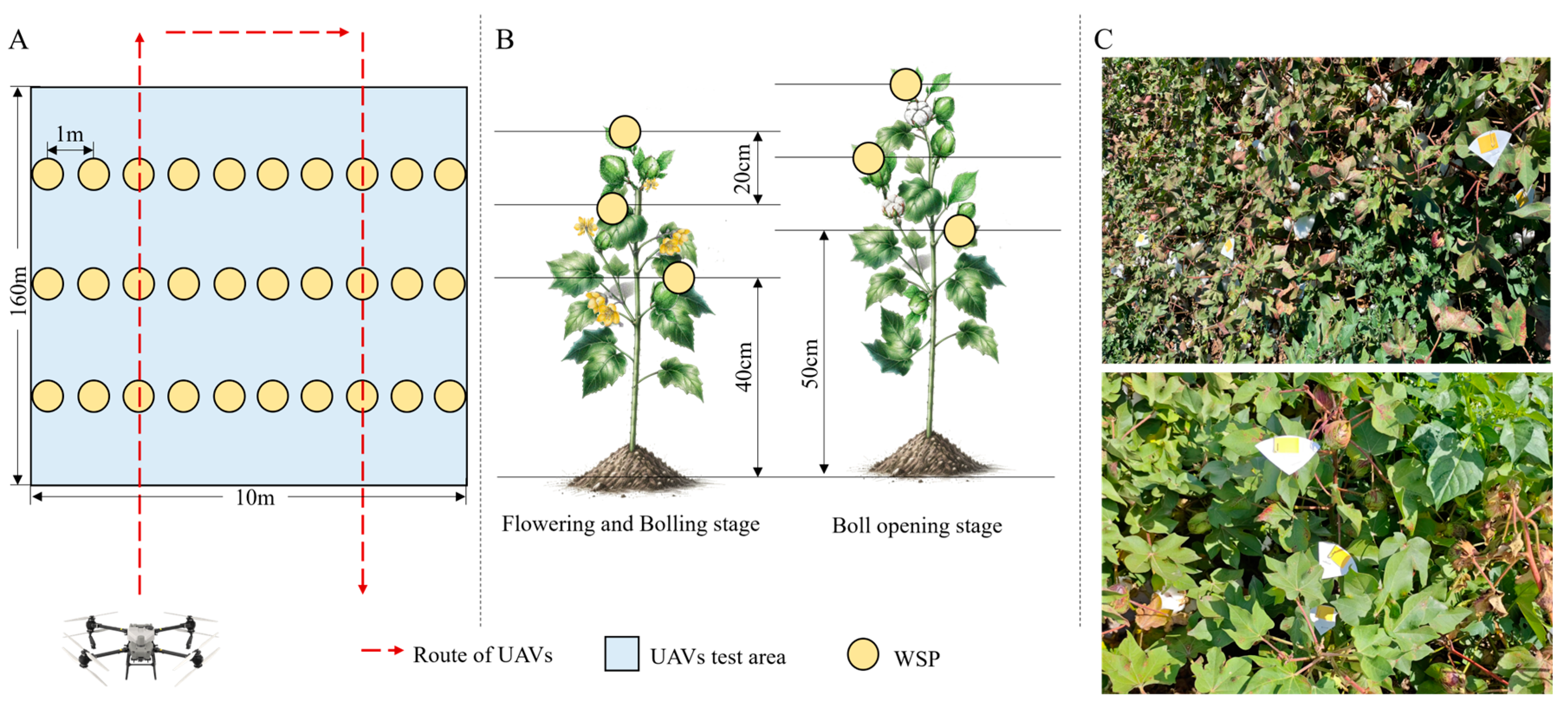
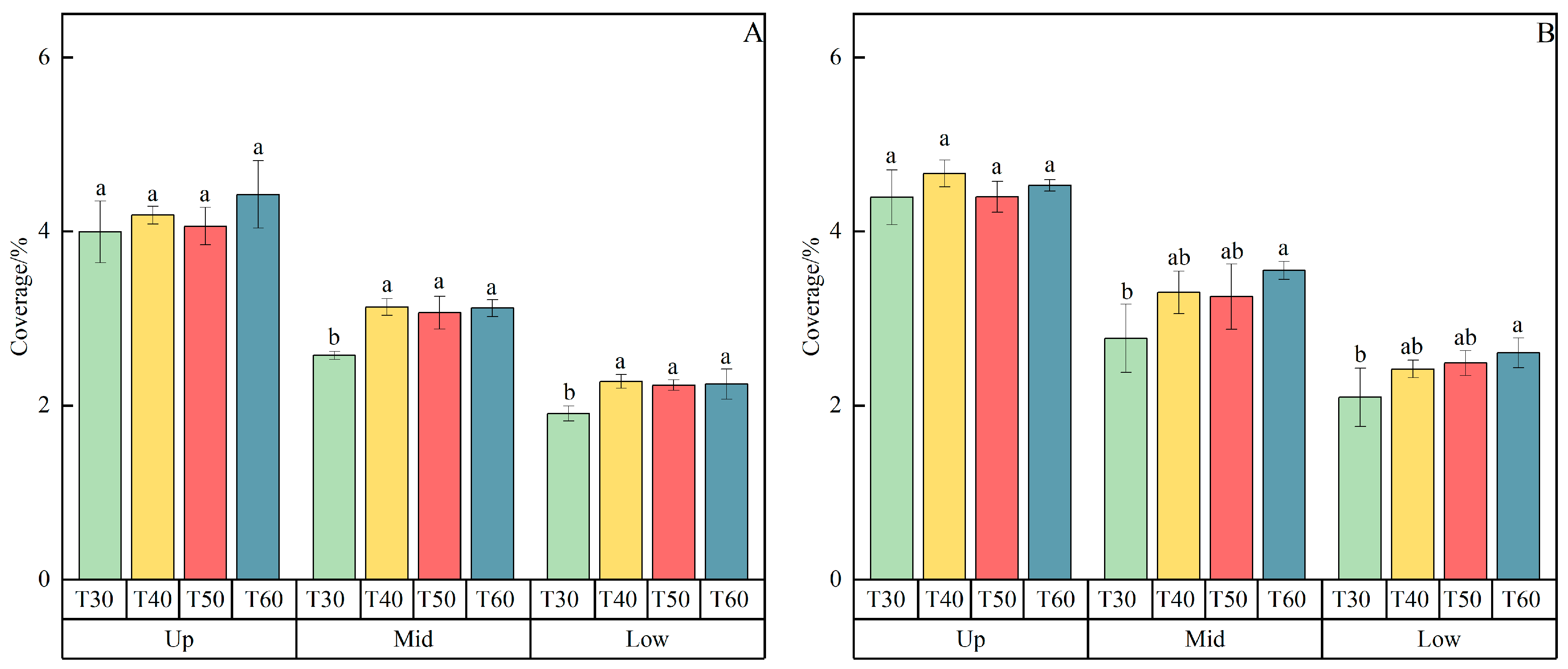
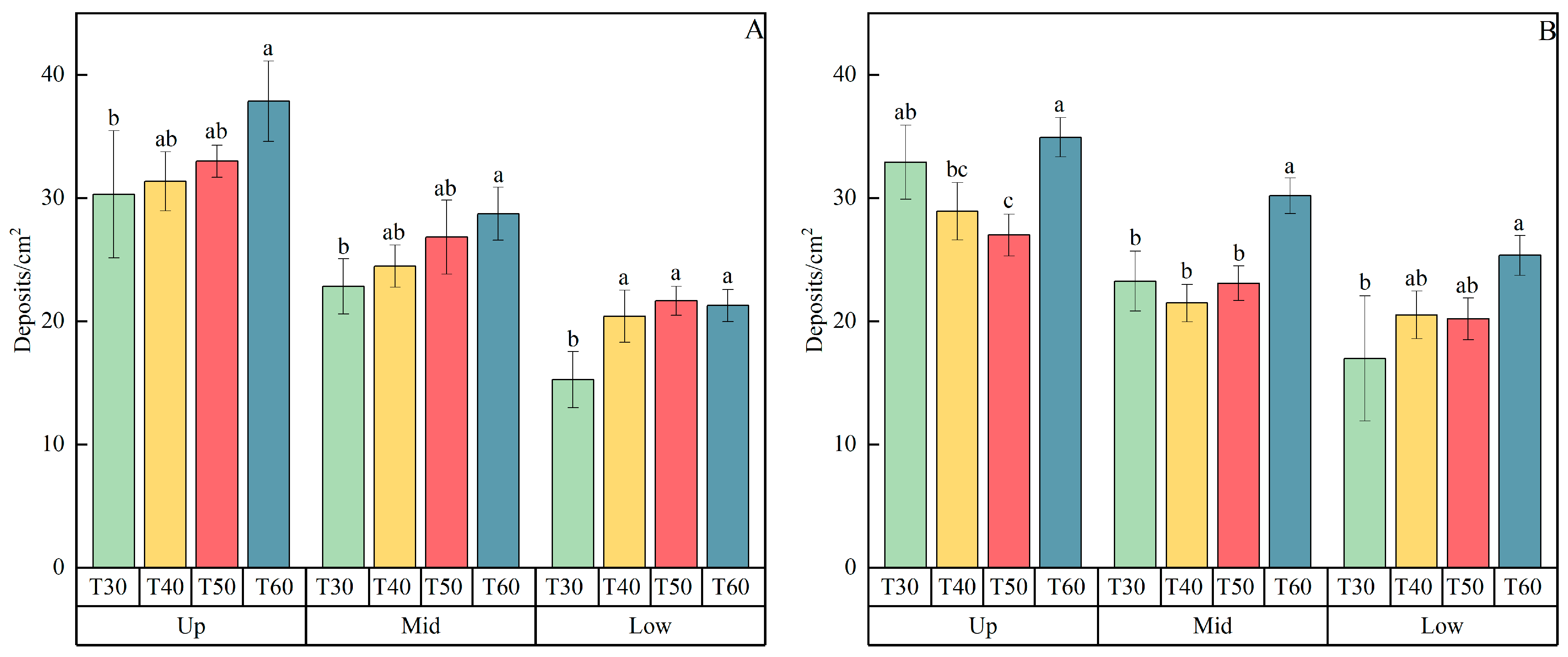
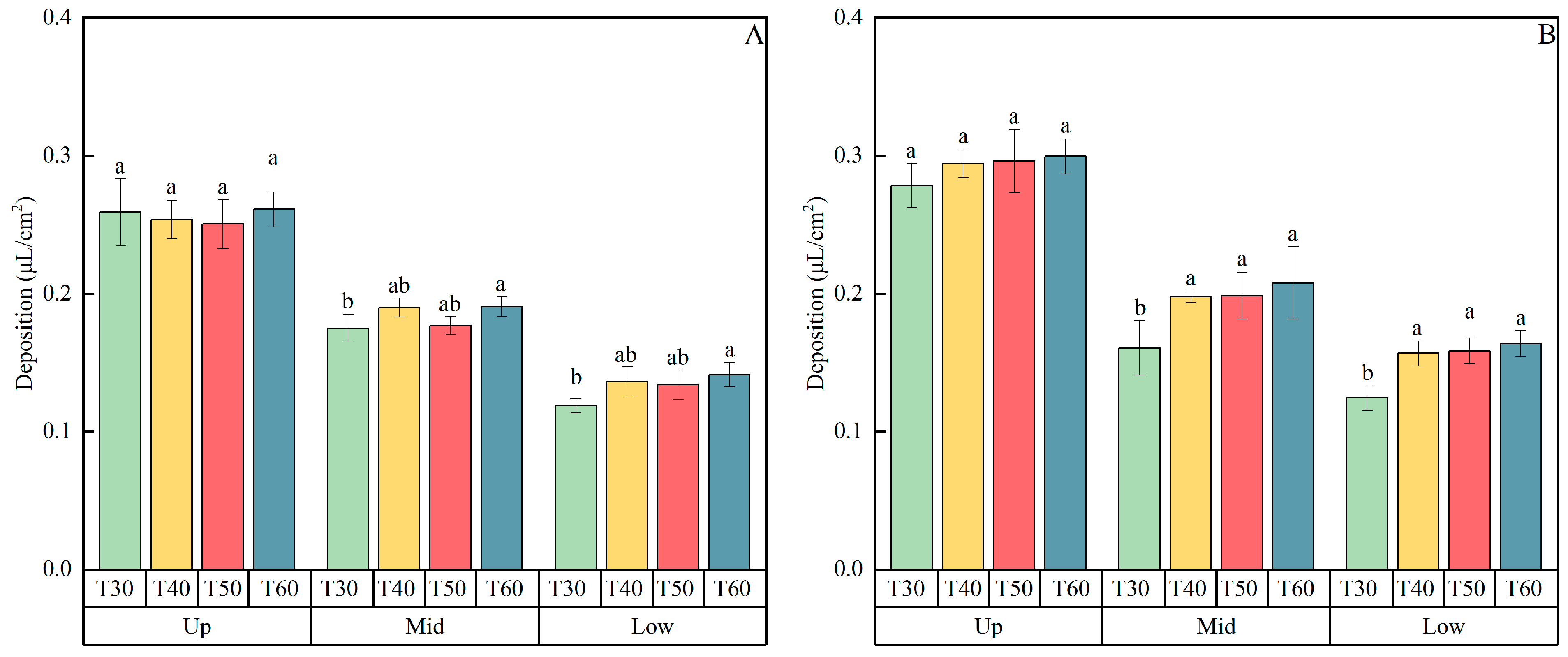
| Date | Air Temperature (°C) | Relative Humidity (%) | Wind Direction | Wind Speed (m/s) | Weather Conditions | Comments |
|---|---|---|---|---|---|---|
| 16 July 2024 | 27.5 | 64.5 | West | 0.5 | Cloudy | Investigate/Spray pesticide |
| 17 July 2024 | 25.1 | 62.4 | East | 1.4 | Cloudy | Investigate |
| 19 July 2024 | 24.6 | 50.5 | West | 1.5 | Cloudy | Investigate |
| 23 July 2024 | 28.2 | 48.8 | Northeast | 1.7 | Cloudy | Investigate |
| 5 September 2024 | 18.1 | 54.5 | Northeast | 1.4 | Sunny | Investigate/Spray defoliant |
| 10 September 2024 | 18.8 | 48.2 | Northeast | 2.1 | Cloudy | Investigate |
| 12 September 2024 | 20.2 | 53.3 | South | 1.1 | Sunny | Investigate/Second spray defoliant |
| 15 September 2024 | 17.1 | 49.5 | East | 2.7 | Cloudy | Investigate |
| 20 September 2024 | 20.9 | 55.3 | Northeast | 1.6 | Sunny | Investigate |
| 25 September 2024 | 23.1 | 60.1 | Northeast | 0.9 | Cloudy | Investigate |
| Sprayers | Tank | Rotor/d | Nozzle | Dimension | Maximum Takeoff Weight |
|---|---|---|---|---|---|
| T30 UAV | 30 L | 6 rotors 38 inches | 16 fan-shaped nozzles, SX11001VS | 2858 × 2685 × 790 mm | 66.5 kg |
| T40 UAV | 40 L | 8 rotors 54 inches | 2 centrifugal nozzles, LX8060SZ | 2800 × 3150 × 780 mm | 90.0 kg |
| T50 UAV | 40 L | 8 rotors 54 inches | 2 centrifugal nozzles, LX8060SZ | 2800 × 3085 × 820 mm | 92.0 kg |
| T60 UAV | 50 L | 4 rotors 56 inches | 2 centrifugal nozzles, LX07550SX | 2870 × 3295 × 900 mm | 112.0 kg |
| Treatment | Uniformity (%) | Penetration (%) | |||
|---|---|---|---|---|---|
| Lower | Middle | Upper | Average | ||
| T30 | 94.97 | 63.59 | 81.78 | 80.11 | 45.83 |
| T40 | 78.73 | 61.11 | 50.91 | 63.58 | 53.74 |
| T50 | 71.89 | 68.35 | 65.41 | 68.55 | 53.45 |
| T60 | 63.14 | 65.88 | 63.27 | 64.10 | 54.09 |
| Treatment | Uniformity (%) | Penetration (%) | |||
|---|---|---|---|---|---|
| Lower | Middle | Upper | Average | ||
| T30 | 81.78 | 63.92 | 58.41 | 67.92 | 44.76 |
| T40 | 79.61 | 59.10 | 57.56 | 65.42 | 53.22 |
| T50 | 75.29 | 68.31 | 48.47 | 64.02 | 53.50 |
| T60 | 56.78 | 64.58 | 56.52 | 59.29 | 56.04 |
| Sprayers | Pesticide Utilization Rate (%) |
|---|---|
| T30 | 75.47 ± 4.53 Aa |
| T40 | 76.13 ± 2.50 Aa |
| T50 | 77.76 ± 1.30 Aa |
| T60 | 77.86 ± 1.12 Aa |
| Boom sprayer | 58.88 ± 1.58 Bb |
| Sprayer | Control Effect (%) | ||
|---|---|---|---|
| 1 Day After Spraying | 3 Days After Spraying | 7 Days After Spraying | |
| T30 | 61.93 c | 79.31 c | 89.03 c |
| T40 | 64.87 b | 81.31 b | 91.55 b |
| T50 | 64.70 b | 81.20 b | 91.35 b |
| T60 | 66.19 b | 80.60 b | 90.99 b |
| Boom sprayer | 76.56 a | 83.38 a | 93.36 a |
| Treatment | Defoliation (%) | ||||
|---|---|---|---|---|---|
| 5 Days After Spraying | 7 Days After Spraying | 10 Days After Spraying | 15 Days After Spraying | 20 Days After Spraying | |
| T30 | 39.77 c | 51.48 c | 61.74 b | 83.42 a | 90.35 a |
| T40 | 42.96 b | 54.18 b | 62.73 b | 85.05 a | 92.29 a |
| T50 | 42.80 b | 53.78 b | 63.29 b | 84.62 a | 91.74 a |
| T60 | 41.01 b | 53.29 b | 62.57 b | 83.64 a | 90.28 a |
| Boom sprayer | 50.03 a | 61.87 a | 70.51 a | 81.15 b | 86.49 b |
| Water (CK) | 9.57 d | 16.35 c | 25.45 c | 36.85 c | 54.86 c |
| Treatment | Boll Opening Rate (%) | |||||
|---|---|---|---|---|---|---|
| Before Spraying | 5 Days After Spraying | 7 Days After Spraying | 10 Days After Spraying | 15 Days After Spraying | 20 Days After Spraying | |
| T30 | 49.06 a | 68.06 b | 75.34 b | 81.19 a | 87.23 a | 92.96 a |
| T40 | 49.52 a | 68.78 b | 75.93 b | 82.05 a | 89.05 a | 93.31 a |
| T50 | 51.15 a | 69.34 b | 75.58 b | 82.62 a | 88.53 a | 93.00 a |
| T60 | 50.37 a | 68.92 b | 76.51 b | 83.03 a | 89.01 a | 92.57 a |
| Boom sprayer | 49.90 a | 72.40 a | 78.87 a | 82.78 a | 88.84 a | 91.98 a |
| Water (CK) | 48.71 a | 60.56 c | 64.93 c | 71.02 b | 76.42 c | 78.82 c |
Disclaimer/Publisher’s Note: The statements, opinions and data contained in all publications are solely those of the individual author(s) and contributor(s) and not of MDPI and/or the editor(s). MDPI and/or the editor(s) disclaim responsibility for any injury to people or property resulting from any ideas, methods, instructions or products referred to in the content. |
© 2025 by the authors. Licensee MDPI, Basel, Switzerland. This article is an open access article distributed under the terms and conditions of the Creative Commons Attribution (CC BY) license (https://creativecommons.org/licenses/by/4.0/).
Share and Cite
Li, H.; Li, Y.; Zeeshan, M.; Yang, L.; Gao, Z.; Yang, Y.; Zhang, G.; Wang, C.; Han, X. The Influence of Unmanned Aerial Vehicle Wind Field on the Pesticide Droplet Deposition and Control Effect in Cotton Fields. Agronomy 2025, 15, 1221. https://doi.org/10.3390/agronomy15051221
Li H, Li Y, Zeeshan M, Yang L, Gao Z, Yang Y, Zhang G, Wang C, Han X. The Influence of Unmanned Aerial Vehicle Wind Field on the Pesticide Droplet Deposition and Control Effect in Cotton Fields. Agronomy. 2025; 15(5):1221. https://doi.org/10.3390/agronomy15051221
Chicago/Turabian StyleLi, Haoran, Ying Li, Muhammad Zeeshan, Longfei Yang, Zhishuo Gao, Yuting Yang, Guoqiang Zhang, Chunjuan Wang, and Xiaoqiang Han. 2025. "The Influence of Unmanned Aerial Vehicle Wind Field on the Pesticide Droplet Deposition and Control Effect in Cotton Fields" Agronomy 15, no. 5: 1221. https://doi.org/10.3390/agronomy15051221
APA StyleLi, H., Li, Y., Zeeshan, M., Yang, L., Gao, Z., Yang, Y., Zhang, G., Wang, C., & Han, X. (2025). The Influence of Unmanned Aerial Vehicle Wind Field on the Pesticide Droplet Deposition and Control Effect in Cotton Fields. Agronomy, 15(5), 1221. https://doi.org/10.3390/agronomy15051221





